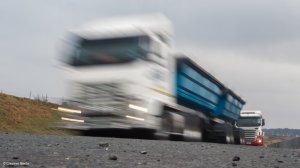Dedicated freight lanes and restricted truck operating hours mooted in draft plan to shift cargo back to rail
The Department of Transport (DoT) is canvasing a series of interventions aimed at attracting freight back to South Africa’s struggling rail system from road, which has emerged as the country’s freight backbone following Transnet Freight Rail’s (TFR’s) precipitous decline in recent years.
Notwithstanding a long-standing road-to-rail policy, the DoT reports that 87% of freight is currently being moved by truck, with volumes moved by TFR having declined sharply from 226-million tons in 2017/18 to only 149.5-million tons in 2022/23.
This calamitous collapse led President Cyril Ramaphosa to form the National Logistics Crisis Committee in 2023, as well as to the development of a new Freight Logistics Roadmap, which was approved by Cabinet late last year.
The roadmap places emphasis on the introduction of private sector participation in both the port container terminals and the freight rail network; moves that would be facilitated by a vertical separation of port and rail infrastructure management of terminal and rail operations respectively.
A subcomponent of the roadmap is the Freight Road to Rail Migration Plan, the draft contents of which were shared by acting chief director Mihlali Gqada during a colloquium, hosted ahead of the February 2 deadline for public comments.
The plan describes the country’s current freight logistics trajectory as “unsustainable” and notes that South Africa’s high logistics costs are placing importers and exporters at a competitive disadvantage.
With logistics costs estimated at 11.3% of gross domestic product (GDP), South African logistics costs are materially higher than the global average of 7% of GDP, while the transport component of these costs is also high at about 55%.
The collapse of rail volumes, Gqada added, was also resulting in road congestion and degradation, along with increased air and noise pollution, as well as higher greenhouse gas emissions.
The draft plan outlines several interventions aimed at clawing back some of the rail-friendly freight that has been lost to road in recent years, while still underlining the importance of continued and expended investment in road, which has become the dominant mode by which trade was currently being facilitated.
Besides greater private sector participation and the vertical separation of rail infrastructure and operations, some of the other actions proposed in the plan for introduction over the coming three to five years, include:
- The establishment of dedicated road freight lanes on all major corridors for certain times of the day, possibly between 18:00 and 06:00;
- The appointment of dedicated freight traffic enforcement officers;
- 24-hour weighbridges along major corridors; and
- Restricted operating hours for freight-truck movement inside cities.
The draft plan also calls for Transnet to begin reporting to the DoT rather than the Department of Public Enterprises, while underlining the importance of the establishment of an independent transport economic regulator, particularly as the rail sector is opened for third-party access.
Despite the current challenges and the loss of market share to other countries, Gqada argued that there was still potential to position South Africa as a gateway to the African market.
Doing so, however, required the emergence of a more sustainable freight transport system, where there was better coordination and interconnectedness between road, rail, air and sea.
Comments
Press Office
Announcements
What's On
Subscribe to improve your user experience...
Option 1 (equivalent of R125 a month):
Receive a weekly copy of Creamer Media's Engineering News & Mining Weekly magazine
(print copy for those in South Africa and e-magazine for those outside of South Africa)
Receive daily email newsletters
Access to full search results
Access archive of magazine back copies
Access to Projects in Progress
Access to ONE Research Report of your choice in PDF format
Option 2 (equivalent of R375 a month):
All benefits from Option 1
PLUS
Access to Creamer Media's Research Channel Africa for ALL Research Reports, in PDF format, on various industrial and mining sectors
including Electricity; Water; Energy Transition; Hydrogen; Roads, Rail and Ports; Coal; Gold; Platinum; Battery Metals; etc.
Already a subscriber?
Forgotten your password?
Receive weekly copy of Creamer Media's Engineering News & Mining Weekly magazine (print copy for those in South Africa and e-magazine for those outside of South Africa)
➕
Recieve daily email newsletters
➕
Access to full search results
➕
Access archive of magazine back copies
➕
Access to Projects in Progress
➕
Access to ONE Research Report of your choice in PDF format
RESEARCH CHANNEL AFRICA
R4500 (equivalent of R375 a month)
SUBSCRIBEAll benefits from Option 1
➕
Access to Creamer Media's Research Channel Africa for ALL Research Reports on various industrial and mining sectors, in PDF format, including on:
Electricity
➕
Water
➕
Energy Transition
➕
Hydrogen
➕
Roads, Rail and Ports
➕
Coal
➕
Gold
➕
Platinum
➕
Battery Metals
➕
etc.
Receive all benefits from Option 1 or Option 2 delivered to numerous people at your company
➕
Multiple User names and Passwords for simultaneous log-ins
➕
Intranet integration access to all in your organisation





















